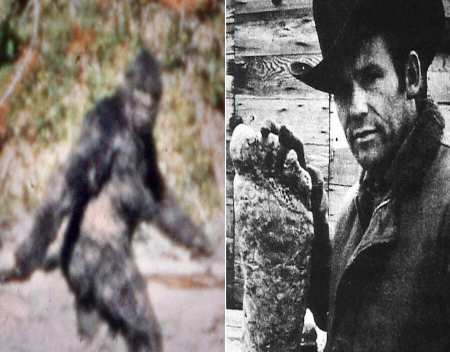Blog Categories
- African Incidents
- Atlantis Incidents
- Australian Incidents
- Belgian Incidents
- Bermuda Triangle Incidents
- Brazilian Incidents
- Canadian Incidents
- Chinese Incidents
- European Incidents
- France Incidents
- Ghosts
- Giants
- Italy Incidents
- Japanese Incidents
- Middle East Incidents
- Portugal Incidents
- Project Serpo
- Puerto Rico Incidents
- Russian Incidents
- Sasquatch
- Scandinavia Incidents
- Spanish Incidents
- UFOs
- United Kingdom Incidents
- United States Incidents
1967: Patterson and Gimlin Bigfoot Encounter

Arguably the most famous and influential Bigfoot footage is the 1967 film shot by Roger Patterson and Bob Gimlin in Northern California. The "Bigfoot walk" it depicts has been parodied by many, but never truly replicated. Even with this enhanced image, it’s hard to tell if it’s a person in a gorilla suit or the real deal.
On Friday, October 20th, 1967, in the early afternoon Patterson and Gimlin were riding generally northeast (upstream) on horseback along the east bank of Bluff Creek. At some time between 1:15 pm and 1:40 p.m., they "came to an overturned tree with a large root system at a turn in the creek, almost as high as a room".
When they rounded it, "there was a logjam, a 'crow's nest', left over from the flood of 1964," and then they spotted the figure behind it nearly simultaneously. It was either "crouching beside the creek to their left" or "standing" there, on the opposite bank. Gimlin later described himself as in a mild state of shock after first seeing the figure.
Patterson initially estimated its height at 6 feet 6 inches to 7 feet and later raised his estimate to about 7 feet 6 inches. Some later analysts, anthropologist Grover Krantz among them, have suggested Patterson's later estimate was about 1 foot too tall. Gimlin's estimate was 6 feet.
The film shows what Patterson and Gimlin claimed was a large, hairy, bipedal, apelike figure with short, "silvery brown" or "dark reddish-brown" or "black" hair covering most of its body, including its prominent breasts. The figure in the film generally matches the descriptions of Bigfoot offered by others who claim to have seen one.
Patterson estimated he was about 25 feet away from the creature at his closest. Patterson said that his horse reared upon sensing the figure, and he spent about 20 seconds extricating himself from the saddle, controlling his horse, getting around to its other side, and getting his camera from a saddlebag before he could run toward the figure while operating his camera. He yelled "Cover me" to Gimlin, "meaning to get the gun out". Gimlin crossed the creek on horseback after Patterson had run well beyond it, riding on a path somewhat to the left of Patterson's and somewhat beyond his position. It's estimated that he came within 60 to 90 feet of "Patty". Then, rifle in hand, he dismounted, but did not point his rifle at the creature.
The figure had walked away from them to a distance of about 120 feet before Patterson began to run after it. The resulting film (about 59.5 seconds long at 16 fps) is initially quite shaky until Patterson got about 80 feet from the figure. At that point, the figure glanced over its right shoulder at the men and Patterson fell to his knees; on Krantz's map this corresponds to frame 264. To researcher John Green, Patterson would later characterize the creature's expression as one of "contempt and disgust ... you know how it is when the umpire tells you 'one more word and you're out of the game.' That's the way it felt."
Shortly after this point the steady, middle portion of the film begins, containing the famous look-back frame 352. Patterson said, "it turned a total of I think three times," the other times therefore being before the filming began and / or while he was running with his finger off the trigger. Shortly after glancing over its shoulder on film, the creature disappeared behind a grove of trees for 14 seconds, then reappeared in the film's final 15 seconds after Patterson moved 10 feet to a better vantage point, fading into the trees again and being lost to view at a distance of 265 feet as the reel of film ran out.
Gimlin remounted and followed it on horseback, keeping his distance, until it disappeared around a bend in the road three hundred yards away. Patterson called him back at that point, feeling vulnerable on foot without a rifle, because he feared the creature's mate might approach. The entire encounter had lasted less than two minutes.
Next, Gimlin and Patterson rounded up Patterson's horses, which had run off in the opposite direction, downstream, before the filming began. Patterson got his second roll of film from his saddlebag and filmed the tracks. Then the men tracked "Patty" for either one mile or three miles, but "lost it in the heavy undergrowth". They went to their campsite three miles south, picked up plaster, returned to the initial site, measured the creature's step-length, and made two plaster casts, one each of the best-quality right and left prints.
According to Patterson and Gimlin, they were the only witnesses to their brief encounter with what they claimed was a Sasquatch.
Resources: wikipedia.org
My Take: This case has been analyzed numerous times by many experts with absolute conclusions in both camps. Saying that, nobody has ever been able to exactly replicate Patty’s gait. Was it 100% proof of Sasquatch? Was it a person in a gorilla suit for some kind of fraud? The jury is still out. Patterson maintained that it was real right up to his death in 1972.

Arguably the most famous and influential Bigfoot footage is the 1967 film shot by Roger Patterson and Bob Gimlin in Northern California. The "Bigfoot walk" it depicts has been parodied by many, but never truly replicated. Even with this enhanced image, it’s hard to tell if it’s a person in a gorilla suit or the real deal.
On Friday, October 20th, 1967, in the early afternoon Patterson and Gimlin were riding generally northeast (upstream) on horseback along the east bank of Bluff Creek. At some time between 1:15 pm and 1:40 p.m., they "came to an overturned tree with a large root system at a turn in the creek, almost as high as a room".
When they rounded it, "there was a logjam, a 'crow's nest', left over from the flood of 1964," and then they spotted the figure behind it nearly simultaneously. It was either "crouching beside the creek to their left" or "standing" there, on the opposite bank. Gimlin later described himself as in a mild state of shock after first seeing the figure.
Patterson initially estimated its height at 6 feet 6 inches to 7 feet and later raised his estimate to about 7 feet 6 inches. Some later analysts, anthropologist Grover Krantz among them, have suggested Patterson's later estimate was about 1 foot too tall. Gimlin's estimate was 6 feet.
The film shows what Patterson and Gimlin claimed was a large, hairy, bipedal, apelike figure with short, "silvery brown" or "dark reddish-brown" or "black" hair covering most of its body, including its prominent breasts. The figure in the film generally matches the descriptions of Bigfoot offered by others who claim to have seen one.
Patterson estimated he was about 25 feet away from the creature at his closest. Patterson said that his horse reared upon sensing the figure, and he spent about 20 seconds extricating himself from the saddle, controlling his horse, getting around to its other side, and getting his camera from a saddlebag before he could run toward the figure while operating his camera. He yelled "Cover me" to Gimlin, "meaning to get the gun out". Gimlin crossed the creek on horseback after Patterson had run well beyond it, riding on a path somewhat to the left of Patterson's and somewhat beyond his position. It's estimated that he came within 60 to 90 feet of "Patty". Then, rifle in hand, he dismounted, but did not point his rifle at the creature.
The figure had walked away from them to a distance of about 120 feet before Patterson began to run after it. The resulting film (about 59.5 seconds long at 16 fps) is initially quite shaky until Patterson got about 80 feet from the figure. At that point, the figure glanced over its right shoulder at the men and Patterson fell to his knees; on Krantz's map this corresponds to frame 264. To researcher John Green, Patterson would later characterize the creature's expression as one of "contempt and disgust ... you know how it is when the umpire tells you 'one more word and you're out of the game.' That's the way it felt."
Shortly after this point the steady, middle portion of the film begins, containing the famous look-back frame 352. Patterson said, "it turned a total of I think three times," the other times therefore being before the filming began and / or while he was running with his finger off the trigger. Shortly after glancing over its shoulder on film, the creature disappeared behind a grove of trees for 14 seconds, then reappeared in the film's final 15 seconds after Patterson moved 10 feet to a better vantage point, fading into the trees again and being lost to view at a distance of 265 feet as the reel of film ran out.
Gimlin remounted and followed it on horseback, keeping his distance, until it disappeared around a bend in the road three hundred yards away. Patterson called him back at that point, feeling vulnerable on foot without a rifle, because he feared the creature's mate might approach. The entire encounter had lasted less than two minutes.
Next, Gimlin and Patterson rounded up Patterson's horses, which had run off in the opposite direction, downstream, before the filming began. Patterson got his second roll of film from his saddlebag and filmed the tracks. Then the men tracked "Patty" for either one mile or three miles, but "lost it in the heavy undergrowth". They went to their campsite three miles south, picked up plaster, returned to the initial site, measured the creature's step-length, and made two plaster casts, one each of the best-quality right and left prints.
According to Patterson and Gimlin, they were the only witnesses to their brief encounter with what they claimed was a Sasquatch.
Resources: wikipedia.org
My Take: This case has been analyzed numerous times by many experts with absolute conclusions in both camps. Saying that, nobody has ever been able to exactly replicate Patty’s gait. Was it 100% proof of Sasquatch? Was it a person in a gorilla suit for some kind of fraud? The jury is still out. Patterson maintained that it was real right up to his death in 1972.

